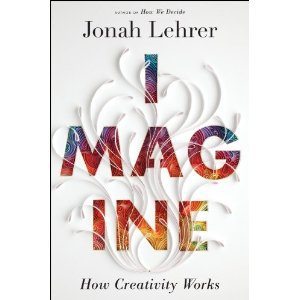 I rarely pre-order a book, but the new book by Jonah Lehrer Imagine: How Creativity Works intrigues me enough that I pre-ordered today. It’s set to be released in just days, March 19th. I read the very interesting essay How to Be Creative by the author in the Wall Street Journal and wanted to share a few of the highlights, though I hope you’ll take time to read it too.
I rarely pre-order a book, but the new book by Jonah Lehrer Imagine: How Creativity Works intrigues me enough that I pre-ordered today. It’s set to be released in just days, March 19th. I read the very interesting essay How to Be Creative by the author in the Wall Street Journal and wanted to share a few of the highlights, though I hope you’ll take time to read it too.
We already know that the idea of some people being “creative types” and others not is a myth. But Jonah does more than merely dispel the myth, he talks about the new science of creativity. He suggests that there are practical things we can do to get the creative juices flowing depending on whether we need sudden insight or stick-to-it late nights at the office. One of my favorites, mostly because I know it to be true from experience, is his suggestion for prompting creativity:
For prompting creativity, few things are as important as time devoted to cross-pollination with fields outside our areas of expertise.
He tells the familiar story of Arthur Fry, the engineer at 3M that came up with the idea of post-it notes. I’ve heard a short version of the story many times, but never all the details that Lehrer shares, about him being a member of a church choir and about his desire of organizing the music he would sing causing the post-it note Eureka moment. (You should read the WSJ article if for no other reason than to get the details of this story.) The disparate needs of 2 areas of his life came together to produce a revolutionary innovation!
Lehrer gives several examples of his point of “cross-pollination” including Steve Jobs:
Steve Jobs famously declared that ‘creativity is just connecting things.’ Although we think of inventors as dreaming up breakthroughs out of thin air, Mr. Jobs was pointing out that even the most far-fetched concepts are usually just new combinations of stuff that already exists.
Or for an earlier example, the Wright brothers, who combined their background as bicycle makers with their desire to fly to come up with the airplane which was really a glorified flying bicycle.
And how does one diversify their interests? One way Lehrer suggests it to make friends with people who possess different passions:
How can people get better at making these kinds of connections? Mr. Jobs argued that the best inventors seek out “diverse experiences,” collecting lots of dots that they later link together. Instead of developing a narrow specialization, they study, say, calligraphy (as Mr. Jobs famously did) or hang out with friends in different fields. Because they don’t know where the answer will come from, they are willing to look for the answer everywhere.
Recent research confirms Mr. Jobs’s wisdom. The sociologist Martin Ruef, for instance, analyzed the social and business relationships of 766 graduates of the Stanford Business School, all of whom had gone on to start their own companies. He found that those entrepreneurs with the most diverse friendships scored three times higher on a metric of innovation. Instead of getting stuck in the rut of conformity, they were able to translate their expansive social circle into profitable new concepts.

I’m ordering this book right now! Looks amazing! Thanks for the post, Wendy!